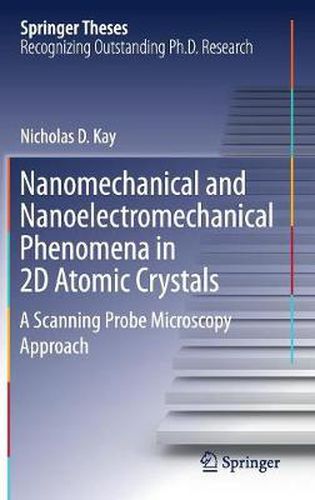Readings Newsletter
Become a Readings Member to make your shopping experience even easier.
Sign in or sign up for free!
You’re not far away from qualifying for FREE standard shipping within Australia
You’ve qualified for FREE standard shipping within Australia
The cart is loading…






This title is printed to order. This book may have been self-published. If so, we cannot guarantee the quality of the content. In the main most books will have gone through the editing process however some may not. We therefore suggest that you be aware of this before ordering this book. If in doubt check either the author or publisher’s details as we are unable to accept any returns unless they are faulty. Please contact us if you have any questions.
This thesis introduces a unique approach of applying atomic force microscopy to study the nanoelectromechanical properties of 2D materials, providing high-resolution computer-generated imagery (CGI) and diagrams to aid readers’ understanding and visualization. The isolation of graphene and, shortly after, a host of other 2D materials has attracted a great deal of interest in the scientific community for both their range of extremely desirable and their record-breaking properties. Amongst these properties are some of the highest elastic moduli and tensile strengths ever observed in nature. The work, which was undertaken at Lancaster University’s Physics department in conjunction with the University of Manchester and the National Physical Laboratory, offers a new approach to understanding the nanomechanical and nanoelectromechanical properties of 2D materials by utilising the nanoscale and nanosecond resolution of ultrasonic force and heterodyne force microscopy (UFM and HFM) - both contact mode atomic force microscopy (AFM) techniques. Using this approach and developing several other new techniques the authors succeeded in probing samples’ subsurface and mechanical properties, which would otherwise remain hidden. Lastly, by using a new technique, coined electrostatic heterodyne force microscopy (E-HFM), the authors were able to observe nanoscale electromechanical vibrations with a nanometre and nanosecond resolution, in addition to probing the local electrostatic environment of devices fabricated from 2D materials.
$9.00 standard shipping within Australia
FREE standard shipping within Australia for orders over $100.00
Express & International shipping calculated at checkout
This title is printed to order. This book may have been self-published. If so, we cannot guarantee the quality of the content. In the main most books will have gone through the editing process however some may not. We therefore suggest that you be aware of this before ordering this book. If in doubt check either the author or publisher’s details as we are unable to accept any returns unless they are faulty. Please contact us if you have any questions.
This thesis introduces a unique approach of applying atomic force microscopy to study the nanoelectromechanical properties of 2D materials, providing high-resolution computer-generated imagery (CGI) and diagrams to aid readers’ understanding and visualization. The isolation of graphene and, shortly after, a host of other 2D materials has attracted a great deal of interest in the scientific community for both their range of extremely desirable and their record-breaking properties. Amongst these properties are some of the highest elastic moduli and tensile strengths ever observed in nature. The work, which was undertaken at Lancaster University’s Physics department in conjunction with the University of Manchester and the National Physical Laboratory, offers a new approach to understanding the nanomechanical and nanoelectromechanical properties of 2D materials by utilising the nanoscale and nanosecond resolution of ultrasonic force and heterodyne force microscopy (UFM and HFM) - both contact mode atomic force microscopy (AFM) techniques. Using this approach and developing several other new techniques the authors succeeded in probing samples’ subsurface and mechanical properties, which would otherwise remain hidden. Lastly, by using a new technique, coined electrostatic heterodyne force microscopy (E-HFM), the authors were able to observe nanoscale electromechanical vibrations with a nanometre and nanosecond resolution, in addition to probing the local electrostatic environment of devices fabricated from 2D materials.